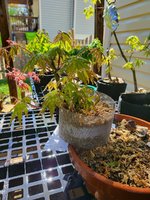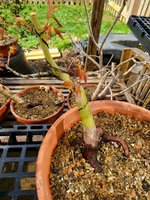Successful air layer Acer Palmatum 'Ikandi'
- Thread starter Ninecloud
- Start date
GGB
Masterpiece
that thing is going to have a wicked pancake underneath it. which is a compliment..
BonsaiDTLA
Shohin
A wicked pancake and some sweet ol maple syrupthat thing is going to have a wicked pancake underneath it. which is a compliment..
fredman
Masterpiece
Nice. Looks like sandwiched the perlite with sphagnum....interesting. I like that...you can just shake the perlite of the roots.
How regularly did you water?
How regularly did you water?
Ninecloud
Yamadori
@fredman I've done em all a bit different and still do air layers like everyone else, but the ground layers I tried to give a bit more of a Peter Warren treatment. For this setup I did sandwich perlite between sphagnum. I think after all my experiments I found that a lot of stuff works with same results. other one I put bonsai mix on the bottom, that worked out too, but anything to hold ther perlite on place, I've even used cut vinyl to hold stuff in place. I also wrap em up in foil. I water every day and sometimes multiple times a day, though I've heard holding back on water helps, I water it with everything else. 



Last edited:
Interesting. Could you please point me to Pater Warren info you are referring to?@fredman I've done em all a bit different and still do air layers like everyone else, but the ground layers I tried to give a bit more of a Peter Warren treatment. For this setup I did sandwich perlite between sphagnum. I think after all my experiments I found that a lot of stuff works with same results. other one I put bonsai mix on the bottom, that worked out too, but anything to hold ther perlite on place, I've even used cut vinyl to hold stuff in place. I also wrap em up in foil. I water every day and sometimes multiple times a day, though I've heard holding back on water helps, I water it with everything else. View attachment 495123View attachment 495122
Ninecloud
Yamadori
Interesting. Could you please point me to Pater Warren info you are referring to?

Air Layering and follow up on defoliated trees - Live Stream with Peter Warren
Looking at air layering trees and also work needed to be done on trees that were defoliated earlier in the year.If this was of use to you then please conside...
Thanks for the link, I will watch it. I know Peter from podcast with Ryan, he always seems to be nice humble guy.He's a pretty well known artist that is also an astrophysicist. It was actually from a bonsainut post is how I came to hear of him.
Air Layering and follow up on defoliated trees - Live Stream with Peter Warren
Looking at air layering trees and also work needed to be done on trees that were defoliated earlier in the year.If this was of use to you then please conside...www.youtube.com
giventofly
Shohin
Quick question, the part where the roots didn't sprout, did you cut that part again or leave it like that ?
Ninecloud
Yamadori
I put more hormones on it, if cambium callus' like that, in my experience, it will root eventually. For the leftover trunk, I cut as far back as I can and seal it with top jin or kiyonal.Quick question, the part where the roots didn't sprout, did you cut that part again or leave it like that ?
fredman
Masterpiece
To add to this question...Quick question, the part where the roots didn't sprout, did you cut that part again or leave it like that ?
I'm wondering why it didn't root as well in this section?
Was this the back side...away from the sun perhaps?
I haven't done a ground air layer from a pot for some time. I promised myself when I do one again...like in this coming spring, i'll turn the pot regularly to give all sides a turn at being heated by the sun.
Like in a quarter turn weekly...
Ninecloud
Yamadori
In my experience, air layering is just really inconsistant. I just get enough roots to remove, I dont think it will root any better on the trunk at that point. I've only had perfect radial nebari off the bat twice, and that is because the nature of a crepe myrtle, and I gave an standard Acer palmaum more time, If I gave it more time removed it would eventually grow them anyway. I usually cover these layers with aluminum foil to protect the roots from sunlight. I believe the sun has little to do with where the roots are produced, and more of where the hormones were focused first. I use a 40% shade cover for my air layers in progress, so they don't have the best sun exposure, i don' think I turned it very much at all except to move the pot and to check the progress.
Ininaatigoons
Shohin
Now that is some Ikandi! Good to see this cultivar layers!
Bonsai Nut
Nuttier than your average Nut
It is strange that I don't see any variegation. Ikandi is a variegated cultivar... though there is some inconsistency with the variegation.
Ninecloud
Yamadori
im glad you mentioned that. There are some explanations of this and it is totally expected, but usually... if you throw off the hormones somehow with variegated trees, they will behave differently. This includes any offense that will involve heavy pruning, root work, air layers, etc. Brent has a great explanation for this, and it took me years to figure it all out but all my variegated varieties do this when we work with them. Even fertilizing will affect a lot of variegated varieties, so its only when i leave the tree alone and prune lightly for about 2-3 years until everything comes back the way its suppose to. Ikandi is a safe one because you can't loose it, its DNA is strong enough that its known not revert, however it undergoes the same phenomenon.It is strange that I don't see any variegation. Ikandi is a variegated cultivar... though there is some inconsistency with the variegation.
"A word about variegated and dwarf (yatsubusa) type Acer palmatum cultivars: Many Japanese maples exhibit juvenile and mature foliage. Juvenile leaves (or reversions) occur when cultivars are pruned hard, grown very vigorously, or after rooted as cuttings. Juvenile leaves are larger, usually green, and do not show many of the characteristics of the mature foliage so desired in the cultivar. What this means is that our cutting grown plants can not exhibit the variegations or the leaf shape or sizes described below of the mature foliage. This phenomenon is most pronounced in variegated and dwarf cultivars. The mature foliage usually appears after about 2 years if plants are not allowed to grow vigorously. Once the plants are dependably producing mature leaves, they will keep their variegations or dwarf configuration unless they are pruned hard, which will induce juvenile foliage again. But this is only a temporary condition and they will again produce mature foliage after a year or two."
he does not go into detail on the why, but i speculate its with hormonal crosstalk and balance.
Ninecloud
Yamadori
seemed to have double posted, but i cant delete HAHA, NOOB!im glad you mentioned that. There are some explanations of this and it is totally expected, but usually... if you throw off the hormones somehow with variegated trees, they will behave differently. This includes any offense that will involve heavy pruning, root work, air layers, etc. Brent has a great explanation for this, and it took me years to figure it all out but all my variegated varieties do this when we work with them. Even fertilizing will affect a lot of variegated varieties, so its only when i leave the tree alone and prune lightly for about 2-3 years until everything comes back the way its suppose to. Ikandi is a safe one because you can't loose it, its DNA is strong enough that its known not revert, however it undergoes the same phenomenon. This is another challenge with working with Vaeigated varieties, some of them will revert, however "Ikandi" is known to always revert back to its mature traits.
"A word about variegated and dwarf (yatsubusa) type Acer palmatum cultivars: Many Japanese maples exhibit juvenile and mature foliage. Juvenile leaves (or reversions) occur when cultivars are pruned hard, grown very vigorously, or after rooted as cuttings. Juvenile leaves are larger, usually green, and do not show many of the characteristics of the mature foliage so desired in the cultivar. What this means is that our cutting grown plants can not exhibit the variegations or the leaf shape or sizes described below of the mature foliage. This phenomenon is most pronounced in variegated and dwarf cultivars. The mature foliage usually appears after about 2 years if plants are not allowed to grow vigorously. Once the plants are dependably producing mature leaves, they will keep their variegations or dwarf configuration unless they are pruned hard, which will induce juvenile foliage again. But this is only a temporary condition and they will again produce mature foliage after a year or two."
he does not go into detail on the why, but i speculate its with hormonal crosstalk and balance.
Similar threads
- Replies
- 36
- Views
- 5K
- Replies
- 10
- Views
- 4K








